Social Responsibility of Business: Analysis and Evaluation Report
VerifiedAdded on 2021/02/20
|8
|2173
|244
Report
AI Summary
This report delves into the multifaceted concept of social responsibility in business, emphasizing its significance in the current market and its impact on both large corporations and small to medium-sized enterprises (SMEs). The report examines various philosophical and practical models of social responsibility, such as the Traditional Conflict Model and the Added Value Model, and applies these models to specific business scenarios, including those of BMW, Google, Microsoft, and Lego. Furthermore, the report analyzes different audit skills to evaluate the ethical and sustainable standings of a range of organizations. Key aspects covered include the importance of considering social and environmental factors alongside profitability, the role of stakeholders, and the application of frameworks like the Triple Bottom Line. The report concludes by highlighting the essential role of social responsibility in business operations and its contribution to social welfare, supported by references to relevant academic research and case studies.
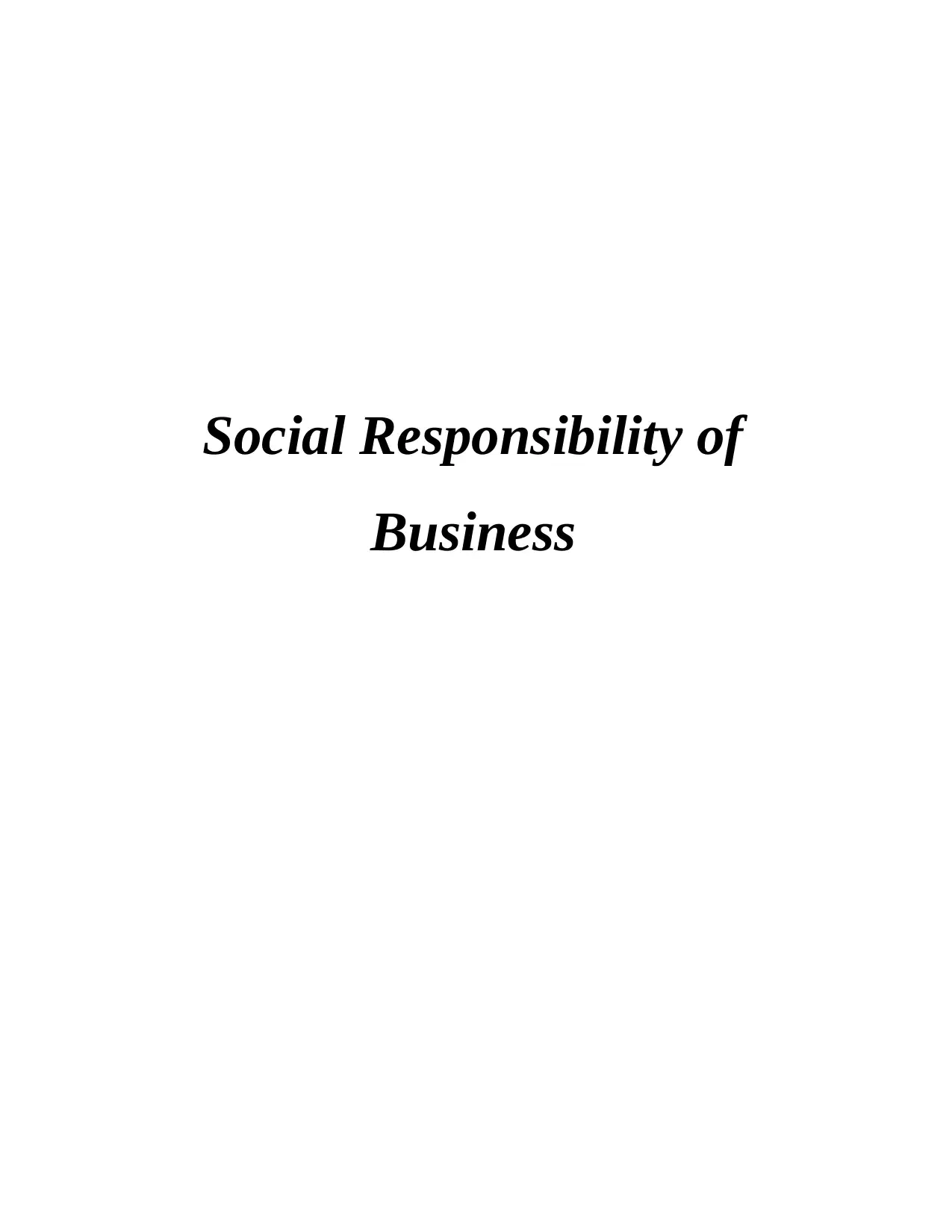
Social Responsibility of
Business
Business
Paraphrase This Document
Need a fresh take? Get an instant paraphrase of this document with our AI Paraphraser
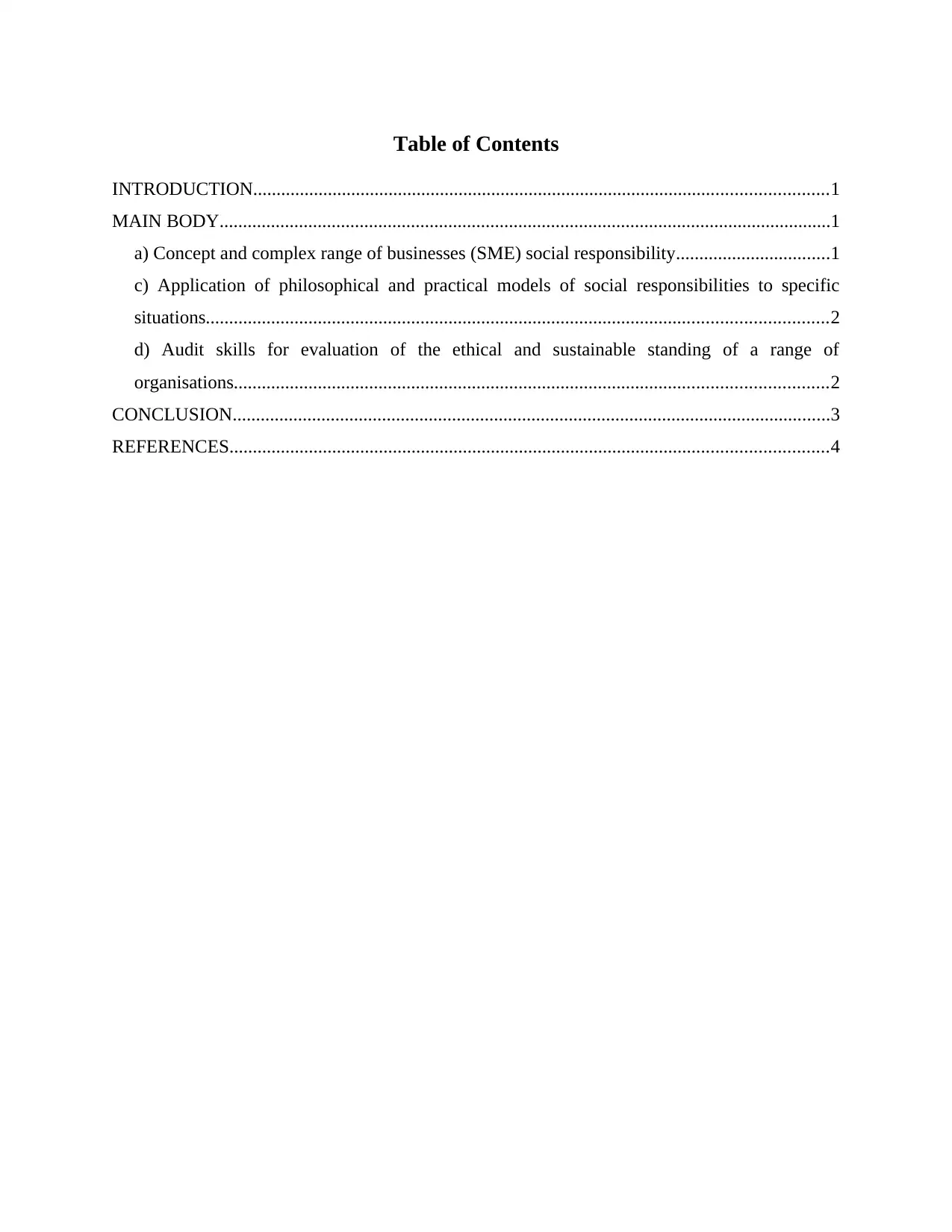
Table of Contents
INTRODUCTION...........................................................................................................................1
MAIN BODY...................................................................................................................................1
a) Concept and complex range of businesses (SME) social responsibility.................................1
c) Application of philosophical and practical models of social responsibilities to specific
situations.....................................................................................................................................2
d) Audit skills for evaluation of the ethical and sustainable standing of a range of
organisations...............................................................................................................................2
CONCLUSION................................................................................................................................3
REFERENCES................................................................................................................................4
INTRODUCTION...........................................................................................................................1
MAIN BODY...................................................................................................................................1
a) Concept and complex range of businesses (SME) social responsibility.................................1
c) Application of philosophical and practical models of social responsibilities to specific
situations.....................................................................................................................................2
d) Audit skills for evaluation of the ethical and sustainable standing of a range of
organisations...............................................................................................................................2
CONCLUSION................................................................................................................................3
REFERENCES................................................................................................................................4
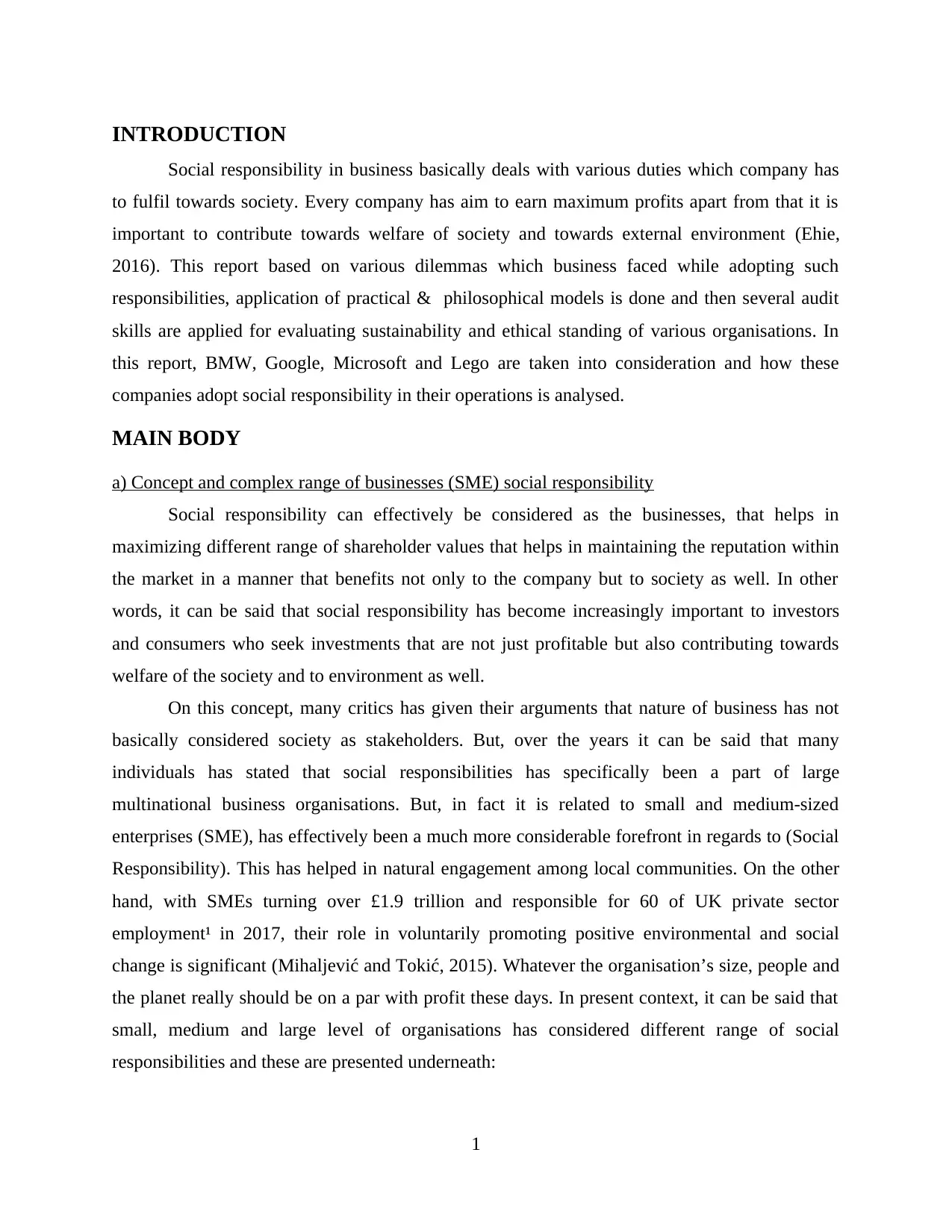
INTRODUCTION
Social responsibility in business basically deals with various duties which company has
to fulfil towards society. Every company has aim to earn maximum profits apart from that it is
important to contribute towards welfare of society and towards external environment (Ehie,
2016). This report based on various dilemmas which business faced while adopting such
responsibilities, application of practical & philosophical models is done and then several audit
skills are applied for evaluating sustainability and ethical standing of various organisations. In
this report, BMW, Google, Microsoft and Lego are taken into consideration and how these
companies adopt social responsibility in their operations is analysed.
MAIN BODY
a) Concept and complex range of businesses (SME) social responsibility
Social responsibility can effectively be considered as the businesses, that helps in
maximizing different range of shareholder values that helps in maintaining the reputation within
the market in a manner that benefits not only to the company but to society as well. In other
words, it can be said that social responsibility has become increasingly important to investors
and consumers who seek investments that are not just profitable but also contributing towards
welfare of the society and to environment as well.
On this concept, many critics has given their arguments that nature of business has not
basically considered society as stakeholders. But, over the years it can be said that many
individuals has stated that social responsibilities has specifically been a part of large
multinational business organisations. But, in fact it is related to small and medium-sized
enterprises (SME), has effectively been a much more considerable forefront in regards to (Social
Responsibility). This has helped in natural engagement among local communities. On the other
hand, with SMEs turning over £1.9 trillion and responsible for 60 of UK private sector
employment¹ in 2017, their role in voluntarily promoting positive environmental and social
change is significant (Mihaljević and Tokić, 2015). Whatever the organisation’s size, people and
the planet really should be on a par with profit these days. In present context, it can be said that
small, medium and large level of organisations has considered different range of social
responsibilities and these are presented underneath:
1
Social responsibility in business basically deals with various duties which company has
to fulfil towards society. Every company has aim to earn maximum profits apart from that it is
important to contribute towards welfare of society and towards external environment (Ehie,
2016). This report based on various dilemmas which business faced while adopting such
responsibilities, application of practical & philosophical models is done and then several audit
skills are applied for evaluating sustainability and ethical standing of various organisations. In
this report, BMW, Google, Microsoft and Lego are taken into consideration and how these
companies adopt social responsibility in their operations is analysed.
MAIN BODY
a) Concept and complex range of businesses (SME) social responsibility
Social responsibility can effectively be considered as the businesses, that helps in
maximizing different range of shareholder values that helps in maintaining the reputation within
the market in a manner that benefits not only to the company but to society as well. In other
words, it can be said that social responsibility has become increasingly important to investors
and consumers who seek investments that are not just profitable but also contributing towards
welfare of the society and to environment as well.
On this concept, many critics has given their arguments that nature of business has not
basically considered society as stakeholders. But, over the years it can be said that many
individuals has stated that social responsibilities has specifically been a part of large
multinational business organisations. But, in fact it is related to small and medium-sized
enterprises (SME), has effectively been a much more considerable forefront in regards to (Social
Responsibility). This has helped in natural engagement among local communities. On the other
hand, with SMEs turning over £1.9 trillion and responsible for 60 of UK private sector
employment¹ in 2017, their role in voluntarily promoting positive environmental and social
change is significant (Mihaljević and Tokić, 2015). Whatever the organisation’s size, people and
the planet really should be on a par with profit these days. In present context, it can be said that
small, medium and large level of organisations has considered different range of social
responsibilities and these are presented underneath:
1
⊘ This is a preview!⊘
Do you want full access?
Subscribe today to unlock all pages.

Trusted by 1+ million students worldwide
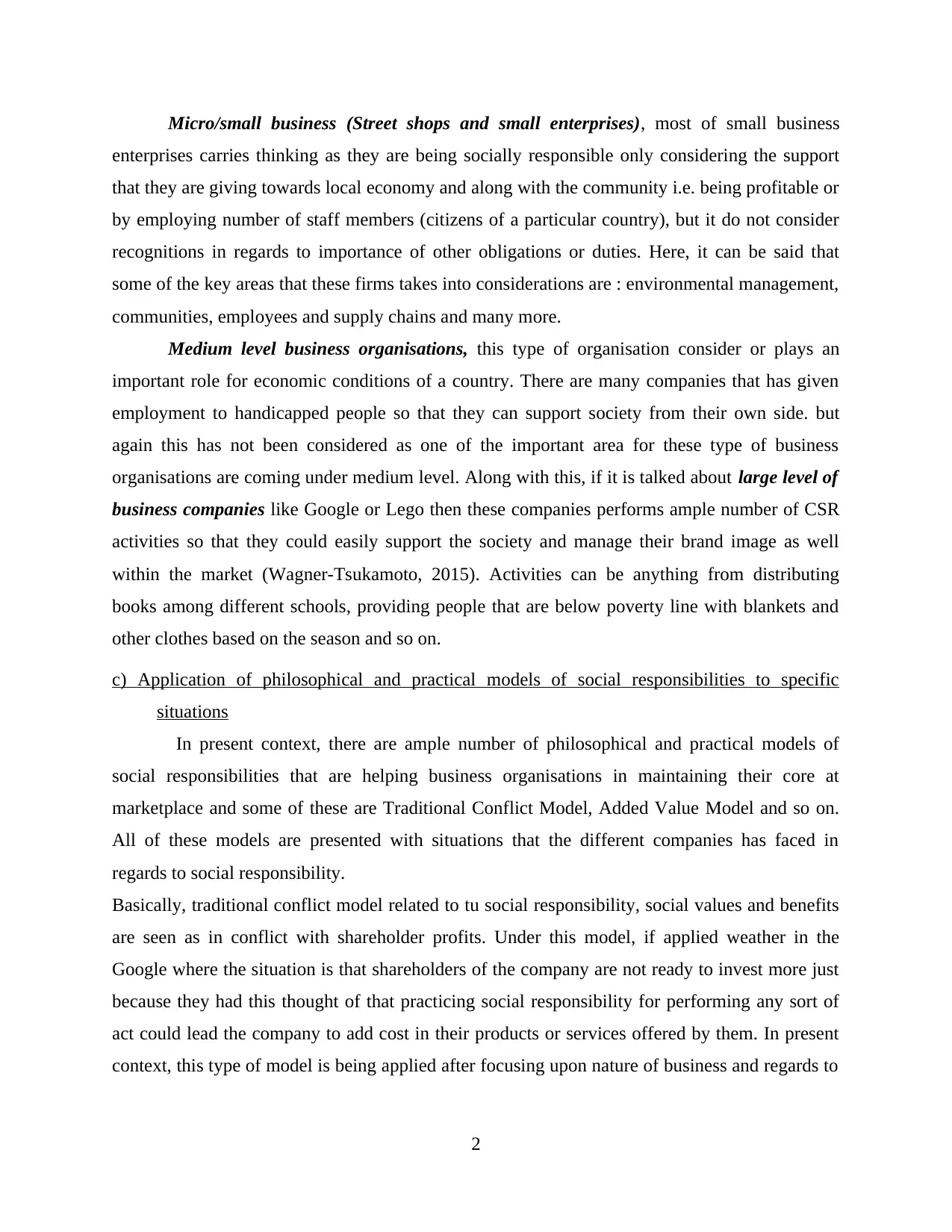
Micro/small business (Street shops and small enterprises), most of small business
enterprises carries thinking as they are being socially responsible only considering the support
that they are giving towards local economy and along with the community i.e. being profitable or
by employing number of staff members (citizens of a particular country), but it do not consider
recognitions in regards to importance of other obligations or duties. Here, it can be said that
some of the key areas that these firms takes into considerations are : environmental management,
communities, employees and supply chains and many more.
Medium level business organisations, this type of organisation consider or plays an
important role for economic conditions of a country. There are many companies that has given
employment to handicapped people so that they can support society from their own side. but
again this has not been considered as one of the important area for these type of business
organisations are coming under medium level. Along with this, if it is talked about large level of
business companies like Google or Lego then these companies performs ample number of CSR
activities so that they could easily support the society and manage their brand image as well
within the market (Wagner-Tsukamoto, 2015). Activities can be anything from distributing
books among different schools, providing people that are below poverty line with blankets and
other clothes based on the season and so on.
c) Application of philosophical and practical models of social responsibilities to specific
situations
In present context, there are ample number of philosophical and practical models of
social responsibilities that are helping business organisations in maintaining their core at
marketplace and some of these are Traditional Conflict Model, Added Value Model and so on.
All of these models are presented with situations that the different companies has faced in
regards to social responsibility.
Basically, traditional conflict model related to tu social responsibility, social values and benefits
are seen as in conflict with shareholder profits. Under this model, if applied weather in the
Google where the situation is that shareholders of the company are not ready to invest more just
because they had this thought of that practicing social responsibility for performing any sort of
act could lead the company to add cost in their products or services offered by them. In present
context, this type of model is being applied after focusing upon nature of business and regards to
2
enterprises carries thinking as they are being socially responsible only considering the support
that they are giving towards local economy and along with the community i.e. being profitable or
by employing number of staff members (citizens of a particular country), but it do not consider
recognitions in regards to importance of other obligations or duties. Here, it can be said that
some of the key areas that these firms takes into considerations are : environmental management,
communities, employees and supply chains and many more.
Medium level business organisations, this type of organisation consider or plays an
important role for economic conditions of a country. There are many companies that has given
employment to handicapped people so that they can support society from their own side. but
again this has not been considered as one of the important area for these type of business
organisations are coming under medium level. Along with this, if it is talked about large level of
business companies like Google or Lego then these companies performs ample number of CSR
activities so that they could easily support the society and manage their brand image as well
within the market (Wagner-Tsukamoto, 2015). Activities can be anything from distributing
books among different schools, providing people that are below poverty line with blankets and
other clothes based on the season and so on.
c) Application of philosophical and practical models of social responsibilities to specific
situations
In present context, there are ample number of philosophical and practical models of
social responsibilities that are helping business organisations in maintaining their core at
marketplace and some of these are Traditional Conflict Model, Added Value Model and so on.
All of these models are presented with situations that the different companies has faced in
regards to social responsibility.
Basically, traditional conflict model related to tu social responsibility, social values and benefits
are seen as in conflict with shareholder profits. Under this model, if applied weather in the
Google where the situation is that shareholders of the company are not ready to invest more just
because they had this thought of that practicing social responsibility for performing any sort of
act could lead the company to add cost in their products or services offered by them. In present
context, this type of model is being applied after focusing upon nature of business and regards to
2
Paraphrase This Document
Need a fresh take? Get an instant paraphrase of this document with our AI Paraphraser
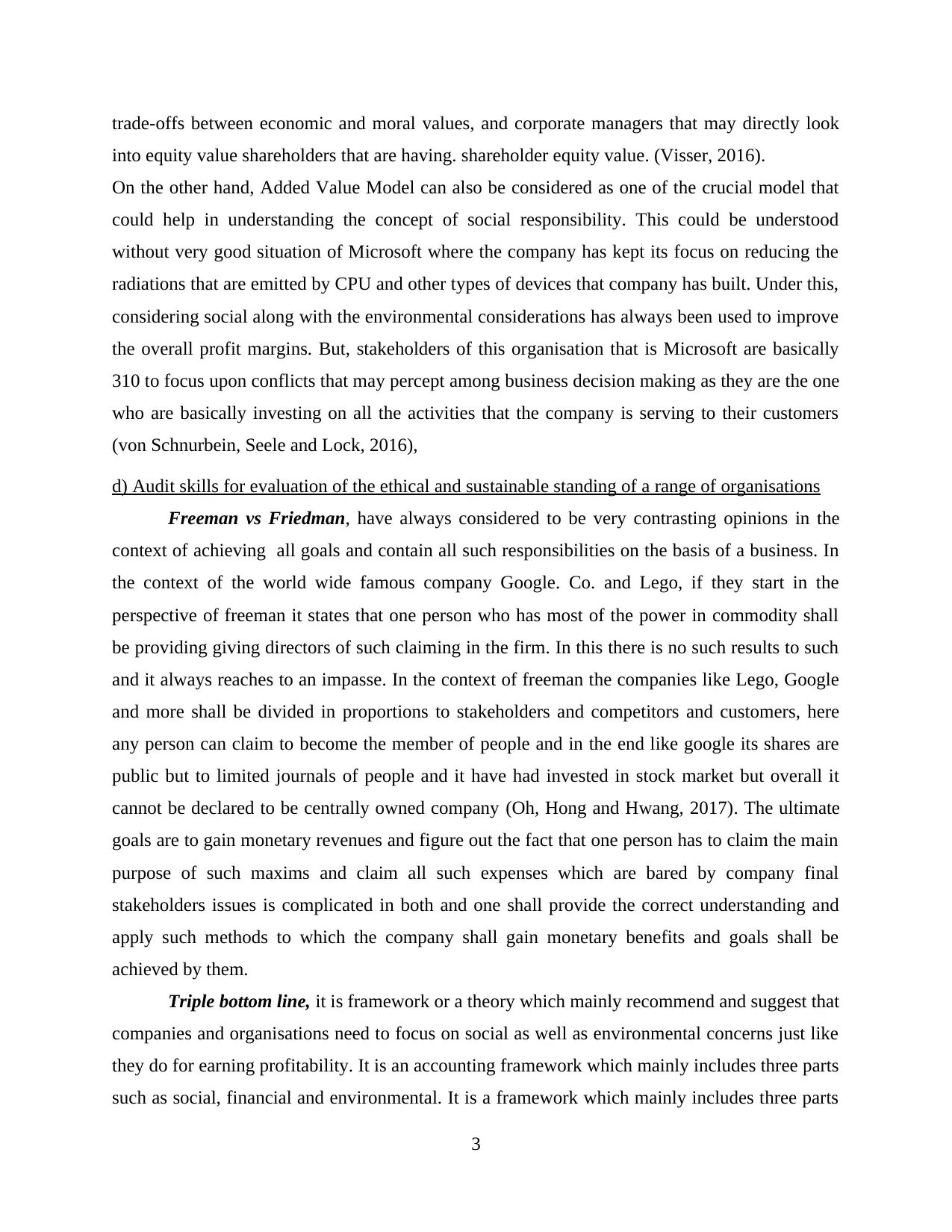
trade-offs between economic and moral values, and corporate managers that may directly look
into equity value shareholders that are having. shareholder equity value. (Visser, 2016).
On the other hand, Added Value Model can also be considered as one of the crucial model that
could help in understanding the concept of social responsibility. This could be understood
without very good situation of Microsoft where the company has kept its focus on reducing the
radiations that are emitted by CPU and other types of devices that company has built. Under this,
considering social along with the environmental considerations has always been used to improve
the overall profit margins. But, stakeholders of this organisation that is Microsoft are basically
310 to focus upon conflicts that may percept among business decision making as they are the one
who are basically investing on all the activities that the company is serving to their customers
(von Schnurbein, Seele and Lock, 2016),
d) Audit skills for evaluation of the ethical and sustainable standing of a range of organisations
Freeman vs Friedman, have always considered to be very contrasting opinions in the
context of achieving all goals and contain all such responsibilities on the basis of a business. In
the context of the world wide famous company Google. Co. and Lego, if they start in the
perspective of freeman it states that one person who has most of the power in commodity shall
be providing giving directors of such claiming in the firm. In this there is no such results to such
and it always reaches to an impasse. In the context of freeman the companies like Lego, Google
and more shall be divided in proportions to stakeholders and competitors and customers, here
any person can claim to become the member of people and in the end like google its shares are
public but to limited journals of people and it have had invested in stock market but overall it
cannot be declared to be centrally owned company (Oh, Hong and Hwang, 2017). The ultimate
goals are to gain monetary revenues and figure out the fact that one person has to claim the main
purpose of such maxims and claim all such expenses which are bared by company final
stakeholders issues is complicated in both and one shall provide the correct understanding and
apply such methods to which the company shall gain monetary benefits and goals shall be
achieved by them.
Triple bottom line, it is framework or a theory which mainly recommend and suggest that
companies and organisations need to focus on social as well as environmental concerns just like
they do for earning profitability. It is an accounting framework which mainly includes three parts
such as social, financial and environmental. It is a framework which mainly includes three parts
3
into equity value shareholders that are having. shareholder equity value. (Visser, 2016).
On the other hand, Added Value Model can also be considered as one of the crucial model that
could help in understanding the concept of social responsibility. This could be understood
without very good situation of Microsoft where the company has kept its focus on reducing the
radiations that are emitted by CPU and other types of devices that company has built. Under this,
considering social along with the environmental considerations has always been used to improve
the overall profit margins. But, stakeholders of this organisation that is Microsoft are basically
310 to focus upon conflicts that may percept among business decision making as they are the one
who are basically investing on all the activities that the company is serving to their customers
(von Schnurbein, Seele and Lock, 2016),
d) Audit skills for evaluation of the ethical and sustainable standing of a range of organisations
Freeman vs Friedman, have always considered to be very contrasting opinions in the
context of achieving all goals and contain all such responsibilities on the basis of a business. In
the context of the world wide famous company Google. Co. and Lego, if they start in the
perspective of freeman it states that one person who has most of the power in commodity shall
be providing giving directors of such claiming in the firm. In this there is no such results to such
and it always reaches to an impasse. In the context of freeman the companies like Lego, Google
and more shall be divided in proportions to stakeholders and competitors and customers, here
any person can claim to become the member of people and in the end like google its shares are
public but to limited journals of people and it have had invested in stock market but overall it
cannot be declared to be centrally owned company (Oh, Hong and Hwang, 2017). The ultimate
goals are to gain monetary revenues and figure out the fact that one person has to claim the main
purpose of such maxims and claim all such expenses which are bared by company final
stakeholders issues is complicated in both and one shall provide the correct understanding and
apply such methods to which the company shall gain monetary benefits and goals shall be
achieved by them.
Triple bottom line, it is framework or a theory which mainly recommend and suggest that
companies and organisations need to focus on social as well as environmental concerns just like
they do for earning profitability. It is an accounting framework which mainly includes three parts
such as social, financial and environmental. It is a framework which mainly includes three parts
3
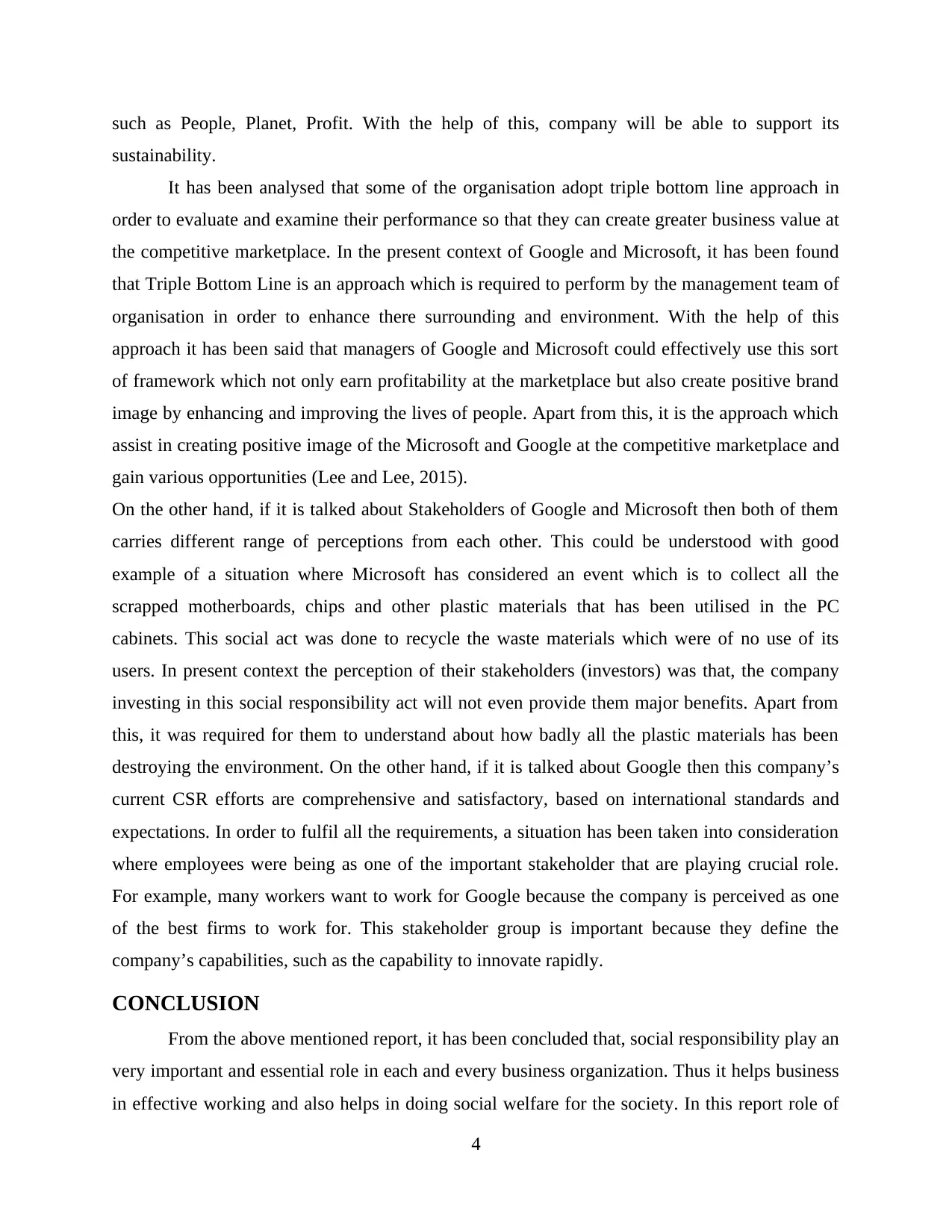
such as People, Planet, Profit. With the help of this, company will be able to support its
sustainability.
It has been analysed that some of the organisation adopt triple bottom line approach in
order to evaluate and examine their performance so that they can create greater business value at
the competitive marketplace. In the present context of Google and Microsoft, it has been found
that Triple Bottom Line is an approach which is required to perform by the management team of
organisation in order to enhance there surrounding and environment. With the help of this
approach it has been said that managers of Google and Microsoft could effectively use this sort
of framework which not only earn profitability at the marketplace but also create positive brand
image by enhancing and improving the lives of people. Apart from this, it is the approach which
assist in creating positive image of the Microsoft and Google at the competitive marketplace and
gain various opportunities (Lee and Lee, 2015).
On the other hand, if it is talked about Stakeholders of Google and Microsoft then both of them
carries different range of perceptions from each other. This could be understood with good
example of a situation where Microsoft has considered an event which is to collect all the
scrapped motherboards, chips and other plastic materials that has been utilised in the PC
cabinets. This social act was done to recycle the waste materials which were of no use of its
users. In present context the perception of their stakeholders (investors) was that, the company
investing in this social responsibility act will not even provide them major benefits. Apart from
this, it was required for them to understand about how badly all the plastic materials has been
destroying the environment. On the other hand, if it is talked about Google then this company’s
current CSR efforts are comprehensive and satisfactory, based on international standards and
expectations. In order to fulfil all the requirements, a situation has been taken into consideration
where employees were being as one of the important stakeholder that are playing crucial role.
For example, many workers want to work for Google because the company is perceived as one
of the best firms to work for. This stakeholder group is important because they define the
company’s capabilities, such as the capability to innovate rapidly.
CONCLUSION
From the above mentioned report, it has been concluded that, social responsibility play an
very important and essential role in each and every business organization. Thus it helps business
in effective working and also helps in doing social welfare for the society. In this report role of
4
sustainability.
It has been analysed that some of the organisation adopt triple bottom line approach in
order to evaluate and examine their performance so that they can create greater business value at
the competitive marketplace. In the present context of Google and Microsoft, it has been found
that Triple Bottom Line is an approach which is required to perform by the management team of
organisation in order to enhance there surrounding and environment. With the help of this
approach it has been said that managers of Google and Microsoft could effectively use this sort
of framework which not only earn profitability at the marketplace but also create positive brand
image by enhancing and improving the lives of people. Apart from this, it is the approach which
assist in creating positive image of the Microsoft and Google at the competitive marketplace and
gain various opportunities (Lee and Lee, 2015).
On the other hand, if it is talked about Stakeholders of Google and Microsoft then both of them
carries different range of perceptions from each other. This could be understood with good
example of a situation where Microsoft has considered an event which is to collect all the
scrapped motherboards, chips and other plastic materials that has been utilised in the PC
cabinets. This social act was done to recycle the waste materials which were of no use of its
users. In present context the perception of their stakeholders (investors) was that, the company
investing in this social responsibility act will not even provide them major benefits. Apart from
this, it was required for them to understand about how badly all the plastic materials has been
destroying the environment. On the other hand, if it is talked about Google then this company’s
current CSR efforts are comprehensive and satisfactory, based on international standards and
expectations. In order to fulfil all the requirements, a situation has been taken into consideration
where employees were being as one of the important stakeholder that are playing crucial role.
For example, many workers want to work for Google because the company is perceived as one
of the best firms to work for. This stakeholder group is important because they define the
company’s capabilities, such as the capability to innovate rapidly.
CONCLUSION
From the above mentioned report, it has been concluded that, social responsibility play an
very important and essential role in each and every business organization. Thus it helps business
in effective working and also helps in doing social welfare for the society. In this report role of
4
⊘ This is a preview!⊘
Do you want full access?
Subscribe today to unlock all pages.

Trusted by 1+ million students worldwide
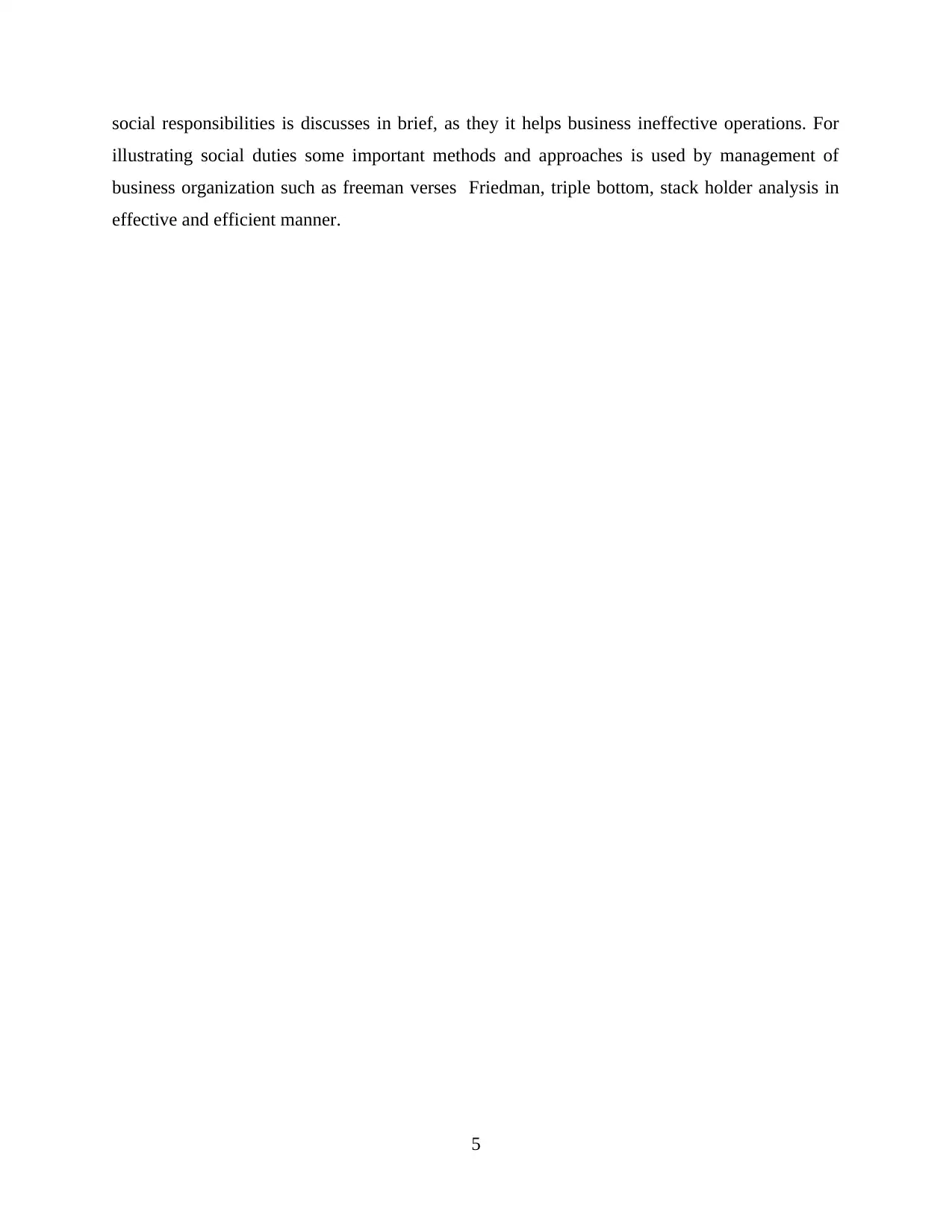
social responsibilities is discusses in brief, as they it helps business ineffective operations. For
illustrating social duties some important methods and approaches is used by management of
business organization such as freeman verses Friedman, triple bottom, stack holder analysis in
effective and efficient manner.
5
illustrating social duties some important methods and approaches is used by management of
business organization such as freeman verses Friedman, triple bottom, stack holder analysis in
effective and efficient manner.
5
Paraphrase This Document
Need a fresh take? Get an instant paraphrase of this document with our AI Paraphraser
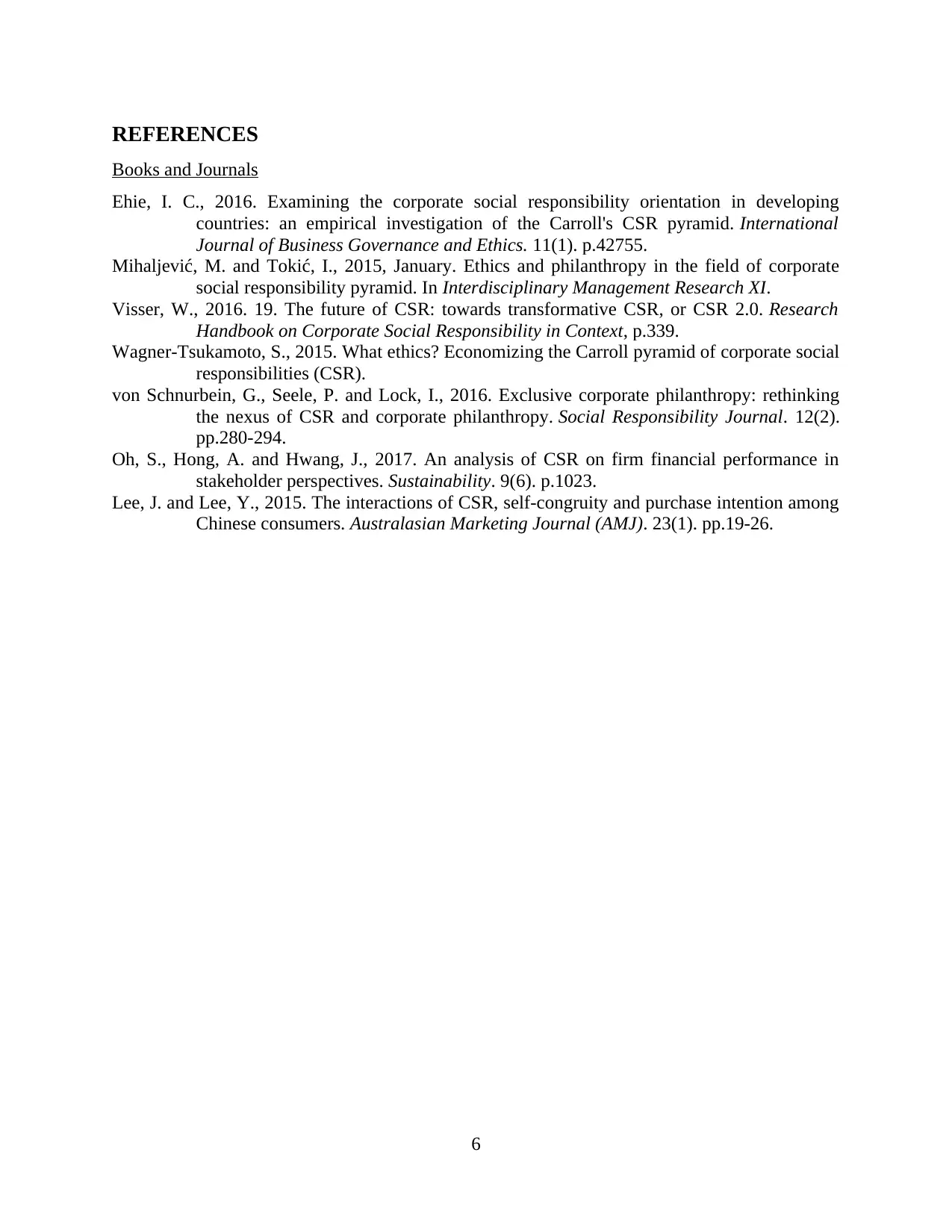
REFERENCES
Books and Journals
Ehie, I. C., 2016. Examining the corporate social responsibility orientation in developing
countries: an empirical investigation of the Carroll's CSR pyramid. International
Journal of Business Governance and Ethics. 11(1). p.42755.
Mihaljević, M. and Tokić, I., 2015, January. Ethics and philanthropy in the field of corporate
social responsibility pyramid. In Interdisciplinary Management Research XI.
Visser, W., 2016. 19. The future of CSR: towards transformative CSR, or CSR 2.0. Research
Handbook on Corporate Social Responsibility in Context, p.339.
Wagner-Tsukamoto, S., 2015. What ethics? Economizing the Carroll pyramid of corporate social
responsibilities (CSR).
von Schnurbein, G., Seele, P. and Lock, I., 2016. Exclusive corporate philanthropy: rethinking
the nexus of CSR and corporate philanthropy. Social Responsibility Journal. 12(2).
pp.280-294.
Oh, S., Hong, A. and Hwang, J., 2017. An analysis of CSR on firm financial performance in
stakeholder perspectives. Sustainability. 9(6). p.1023.
Lee, J. and Lee, Y., 2015. The interactions of CSR, self-congruity and purchase intention among
Chinese consumers. Australasian Marketing Journal (AMJ). 23(1). pp.19-26.
6
Books and Journals
Ehie, I. C., 2016. Examining the corporate social responsibility orientation in developing
countries: an empirical investigation of the Carroll's CSR pyramid. International
Journal of Business Governance and Ethics. 11(1). p.42755.
Mihaljević, M. and Tokić, I., 2015, January. Ethics and philanthropy in the field of corporate
social responsibility pyramid. In Interdisciplinary Management Research XI.
Visser, W., 2016. 19. The future of CSR: towards transformative CSR, or CSR 2.0. Research
Handbook on Corporate Social Responsibility in Context, p.339.
Wagner-Tsukamoto, S., 2015. What ethics? Economizing the Carroll pyramid of corporate social
responsibilities (CSR).
von Schnurbein, G., Seele, P. and Lock, I., 2016. Exclusive corporate philanthropy: rethinking
the nexus of CSR and corporate philanthropy. Social Responsibility Journal. 12(2).
pp.280-294.
Oh, S., Hong, A. and Hwang, J., 2017. An analysis of CSR on firm financial performance in
stakeholder perspectives. Sustainability. 9(6). p.1023.
Lee, J. and Lee, Y., 2015. The interactions of CSR, self-congruity and purchase intention among
Chinese consumers. Australasian Marketing Journal (AMJ). 23(1). pp.19-26.
6
1 out of 8
Related Documents
Your All-in-One AI-Powered Toolkit for Academic Success.
+13062052269
info@desklib.com
Available 24*7 on WhatsApp / Email
![[object Object]](/_next/static/media/star-bottom.7253800d.svg)
Unlock your academic potential
Copyright © 2020–2025 A2Z Services. All Rights Reserved. Developed and managed by ZUCOL.





